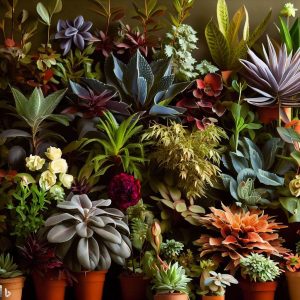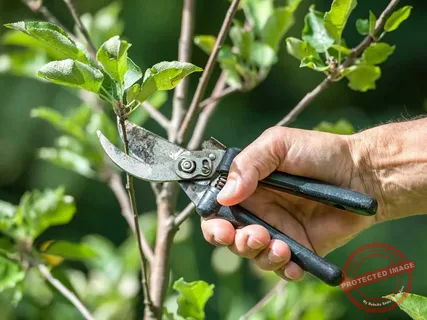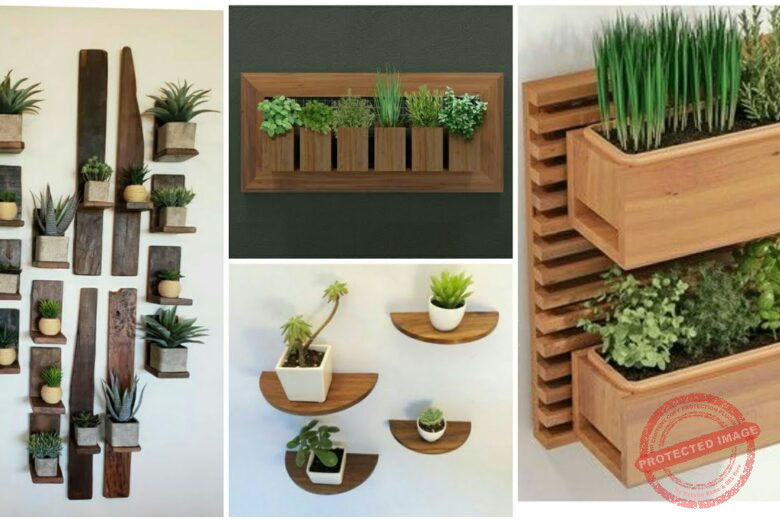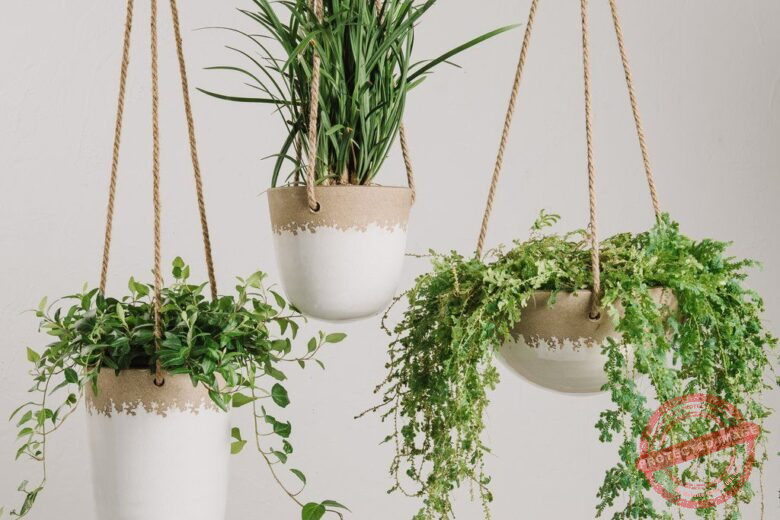Gardening is a fulfilling and rewarding hobby that brings nature closer to home. Whether you have a sprawling garden or a cozy balcony, getting started with gardening can be a delightful experience. However, as a beginner, choosing the right plants can be a bit overwhelming.
As a beginner, some of the best plants to start growing include Marigolds, Zinnia, Pansies, Cosmos, Basil, Mint, Chives, and Rosemary.
In this article, we will explore the 50 best beginner plants for gardening, each carefully selected for their ease of care, resilience, and visual appeal. Let’s dive in and discover the wonderful world of beginner-friendly plants!
50 Best Beginner Plants for Gardening: A Comprehensive Guide
Gardening offers a unique connection with nature and a chance to nurture living things. As a beginner, the right plant selection is crucial for building confidence and ensuring a successful gardening journey. In this article, we will introduce you to a diverse range of plants that are well-suited for beginners. Whether you’re interested in colorful flowers, aromatic herbs, fresh vegetables, or trendy succulents, we’ve got you covered!

1. Marigold (Tagetes spp.)
Marigolds are vibrant annuals known for their pest-repellent properties and cheerful blooms. They come in various colors, including shades of yellow, orange, and red. Marigolds are easy to grow from seeds and can tolerate different soil types. They thrive in full sun and require minimal maintenance, making them a fantastic choice for beginners.
Read Also: 25 Easiest Vegetables To Grow Indoors
2. Zinnia (Zinnia spp.)
Zinnias are popular for their stunning, multi-petaled flowers that come in a wide range of colors. These annuals attract butterflies and are excellent for cut flower arrangements. Zinnias prefer full sun and well-draining soil. Regular deadheading will encourage continuous blooming.
3. Pansy (Viola tricolor)
Pansies are cold-hardy flowers with charming “faces.” They come in a variety of colors, making them perfect for adding a pop of color to your garden, especially during cooler months. Pansies can thrive in both sun and partial shade, and they appreciate regular watering.
Read Also: 25 Fastest Growing Vegetables in Summer
4. Cosmos (Cosmos spp.)
Cosmos are delicate, daisy-like flowers that add a touch of elegance to gardens. They come in various shades, from pink and white to orange and red. Cosmos are low-maintenance and attract pollinators. These annuals thrive in full sun and well-draining soil.
5. Basil (Ocimum basilicum)
Basil is an aromatic herb used in various culinary dishes. It thrives in warm conditions and requires well-draining soil. Basil can be grown in containers or directly in the ground. Regular harvesting of leaves promotes bushier growth.
Read Also: [Complete Guide] 50 Gardening Tips For Beginners
6. Mint (Mentha spp.)
Mint offers a refreshing aroma and is perfect for teas, cocktails, and desserts. Mint can be invasive, so it’s best grown in containers to prevent it from taking over the garden. It prefers partial shade and moist soil.
7. Chives (Allium schoenoprasum)
Chives are versatile herbs with an onion-like flavor. They produce lovely purple flowers that are also edible. Chives are easy to grow and can thrive in both containers and garden beds. They prefer full sun to partial shade.
Read Also: How Fast Do Cucumbers Grow? 10 Tips to Accelerate Growth
8. Rosemary (Rosmarinus officinalis)
Rosemary is a fragrant herb known for its needle-like leaves. It’s drought-tolerant and thrives in sunny locations. Rosemary can be grown in containers or in the ground, and it’s often used in savory dishes.
9. Tomato (Solanum lycopersicum)
Tomatoes are a popular choice for beginners due to their juicy and flavorful fruits. There are various types, including cherry, beefsteak, and roma tomatoes. Tomatoes require full sun and well-draining soil. Staking or caging is recommended to support their growth.
Read Also: How Fast Do Strawberries Grow? 10 Tips to Boost Growth
10. Lettuce (Lactuca sativa)
Lettuce is easy to grow and perfect for salads. It comes in various varieties, such as leaf lettuce, romaine, and butterhead. Lettuce prefers cooler temperatures and can tolerate partial shade. Successive planting ensures a continuous harvest.
11. Radish (Raphanus sativus)
Radishes mature quickly, making them a satisfying choice for beginners. They come in various colors and shapes. Radishes prefer cooler weather and can be planted directly in the ground. Well-draining soil is essential to prevent root issues.
Read Also: [Beginners Guide] How to Grow Avocado from Stone Using Toothpick
12. Carrot (Daucus carota sativus)
Carrots are root vegetables that thrive in loose, well-draining soil. They come in different colors, including orange, purple, and white. Carrots require deep soil to accommodate their taproots and benefit from consistent moisture.
13. Succulent Echeveria (Echeveria spp.)
Succulents, like Echeveria, are known for their water-storing leaves and minimal care requirements. They come in various colors and textures, adding visual interest to gardens. Succulents prefer bright sunlight and well-draining soil.
Read Also: [Beginner’s Guide] How To Grow Watermelon In Africa
14. Golden Barrel Cactus (Echinocactus grusonii)
The Golden Barrel Cactus adds a touch of the desert to your garden. It’s a low-maintenance plant that requires infrequent watering. This cactus prefers full sun and well-draining soil to prevent root rot.
15. Hens and Chicks (Sempervivum spp.)
Hens and Chicks are hardy succulents that propagate easily. They form rosette-like clusters and come in various colors. These succulents are drought-tolerant and thrive in well-draining soil. They can be grown in containers or directly in the ground.
Read Also: 50 Fastest Growing Vegetables and Fruits [2-9 Weeks]
16. Aloe Vera (Aloe barbadensis miller)
Aloe vera is known for its soothing gel, often used for treating skin issues. This succulent requires bright sunlight and well-draining soil. Allow the soil to dry out between waterings to prevent root rot.
17. Petunia (Petunia spp.)
Petunias are versatile annuals known for their trumpet-shaped flowers. They come in various colors and can be grown in containers, hanging baskets, or garden beds. Petunias thrive in full sun and well-draining soil.
18. Geranium (Pelargonium spp.)
Geraniums are classic flowering plants that add charm to any garden. They come in various colors and types, including upright and trailing varieties. Geraniums prefer full sun and well-draining soil.
19. Snapdragon (Antirrhinum majus)
Snapdragons are tall, elegant flowers with distinctive “snapping” blooms. They come in various colors and are excellent for adding vertical interest to gardens. Snapdragons thrive in cooler weather and appreciate well-draining soil.
Read Also: [Pdf Sample] Fruit And Vegetable Business Plan Docx
20. Daffodil (Narcissus spp.)
Daffodils are spring-blooming bulbs known for their trumpet-shaped flowers. They come in different sizes and colors, adding a touch of elegance to gardens. Daffodils prefer full sun to partial shade and well-draining soil.
21. Begonia (Begonia spp.)
Begonias are versatile plants with attractive foliage and charming flowers. They come in various sizes and types, including fibrous-rooted and tuberous begonias. Begonias prefer partial shade and well-draining soil.
22. Carnation (Dianthus caryophyllus)
Carnations are popular for their fragrant, ruffled flowers that come in various colors. They are suitable for borders, containers, and cut flower arrangements. Carnations prefer full sun to partial shade and well-draining soil.
23. Cherry Tomato (Solanum lycopersicum var. cerasiforme)
Cherry tomatoes are small, sweet fruits that are perfect for snacking and salads. They require similar care to regular tomatoes, including full sun and well-draining soil. Cherry tomatoes can be grown in containers as well.
Read Also: How to Make the Best Soil for Tomatoes
24. Spinach (Spinacia oleracea)
Spinach is a nutrient-rich leafy green that’s easy to grow. It thrives in cooler temperatures and prefers partial shade. Spinach can be planted in both garden beds and containers, providing a continuous supply of fresh greens.
25. Cucumber (Cucumis sativus)
Cucumbers are vining vegetables that produce crisp and refreshing fruits. They require ample sunlight, well-draining soil, and support for their vines. Cucumbers can be grown vertically using trellises.
Read Also: Best Soil Mixture for Growing Tomatoes in Containers
26. Pepper (Capsicum spp.)
Peppers come in various types, including bell peppers and chili peppers. They require full sun and well-draining soil. Peppers can be grown in containers or in the ground, and they offer a range of flavors and heat levels.
27. Lavender (Lavandula spp.)
Lavender is a fragrant herb known for its aromatic flowers and soothing properties. It thrives in sunny locations and well-draining soil. Lavender can be grown in containers, garden beds, or used for landscaping.
28. Thyme (Thymus spp.)
Thyme is a versatile herb with aromatic leaves that add flavor to various dishes. It prefers full sun and well-draining soil. Thyme can be grown in containers, garden beds, or even in crevices between stones.
29. Oregano (Origanum vulgare)
Oregano is a culinary herb with a strong flavor that’s commonly used in Mediterranean cuisine. It thrives in full sun and well-draining soil. Oregano can be grown in containers or directly in the ground.
30. Cilantro (Coriandrum sativum)
Cilantro, also known as coriander, is an herb with flavorful leaves and seeds. It prefers cooler temperatures and can be grown in both sun and partial shade. Cilantro can be harvested for leaves and seeds.
31. Sage (Salvia officinalis)
Sage is an aromatic herb with silvery-green leaves that add depth to dishes. It requires full sun and well-draining soil. Sage can be grown in containers or directly in the ground and is often used in stuffing and savory recipes.
32. Peppermint (Mentha × piperita)
Peppermint offers a strong and refreshing aroma, perfect for teas and desserts. It’s best grown in containers to prevent spreading. Peppermint prefers partial shade and consistently moist soil.
33. Lemon Balm (Melissa officinalis)
Lemon balm is a lemon-scented herb that’s great for teas and infusions. It prefers partial shade and moist soil. Lemon balm can be grown in containers or in garden beds, but it may spread if not contained.
34. Cabbage (Brassica oleracea)
Cabbage is a leafy green vegetable that’s part of the Brassica family. It prefers cooler temperatures and well-draining soil. Cabbage can be grown in both garden beds and containers.
35. Kale (Brassica oleracea)
Kale is a nutrient-rich leafy green that’s becoming increasingly popular. It thrives in cooler temperatures and prefers partial shade. Kale can be grown in containers and garden beds.
36. Bell Pepper (Capsicum annuum)
Bell peppers come in various colors and sizes, adding color and flavor to dishes. They require full sun and well-draining soil. Bell peppers can be grown in containers or directly in the ground.
37. Echeveria (Echeveria spp.)
Echeverias are succulents known for their rosette-shaped foliage and vibrant colors. They thrive in bright sunlight and well-draining soil. Echeverias are excellent for container gardening and rock gardens.
38. Jade Plant (Crassula ovata)
The jade plant is a popular succulent with thick, fleshy leaves. It’s easy to care for and prefers bright sunlight. Jade plants are often grown in containers and are known for their resilience.
39. African Violet (Saintpaulia spp.)
African violets are charming flowering plants with fuzzy leaves and colorful blooms. They prefer bright, indirect light and well-draining soil. African violets are often grown indoors in containers.
40. Spider Plant (Chlorophytum comosum)
Spider plants are known for their arching leaves and air-purifying qualities. They thrive in bright, indirect light and well-draining soil. Spider plants are often grown as indoor houseplants.
41. ZZ Plant (Zamioculcas zamiifolia)
The ZZ plant is a low-maintenance indoor plant with glossy, dark green leaves. It tolerates low light conditions and infrequent watering. ZZ plants are excellent choices for beginners and busy individuals.
42. Snake Plant (Sansevieria trifasciata)
Snake plants, also known as mother-in-law’s tongue, have tall, upright leaves. They thrive in low light conditions and prefer to dry out between waterings. Snake plants are popular indoor plants.
43. Pothos (Epipremnum aureum)
Pothos are trailing vines with heart-shaped leaves that come in various colors. They tolerate low light and are easy to propagate. Pothos are often grown as hanging plants or in containers.
44. English Ivy (Hedera helix)
English ivy is a classic trailing plant with lush, green leaves. It can be grown indoors or outdoors and prefers bright, indirect light. English ivy is often used for ground cover or in hanging baskets.
46. Peace Lily (Spathiphyllum spp.)
Peace lilies are elegant indoor plants with white, spoon-shaped blooms. They prefer low to medium light and consistently moist soil. Peace lilies are known for their air-purifying qualities.
47. Bamboo Palm (Chamaedorea seifrizii)
The bamboo palm is an indoor palm with feathery fronds. It prefers bright, indirect light and consistently moist soil. Bamboo palms add a tropical touch to interior spaces.
48. Rubber Plant (Ficus elastica)
The rubber plant is a popular indoor plant with large, glossy leaves. It prefers bright, indirect light and well-draining soil. Rubber plants are known for their attractive foliage.
49. Dracaena (Dracaena spp.)
Dracaenas are versatile indoor plants with various leaf shapes and colors. They tolerate low to bright light and prefer well-draining soil. Dracaenas are often grown in containers.
50. Schefflera (Schefflera spp.)
Scheffleras are indoor plants with distinctive palmate leaves. They prefer bright, indirect light and well-draining soil. Scheffleras are often used for adding a tropical vibe to interiors.
51. Cactus (Cactaceae family)
Cacti come in various shapes and sizes, and they are known for their water-storing capabilities. They thrive in bright sunlight and well-draining soil. Cacti are popular choices for both indoor and outdoor gardening.
What is the Easiest Plant to Grow in a Garden?
Gardening can be a rewarding and fulfilling hobby, especially when you start with plants that are easy to grow. For beginners and those looking for low-maintenance options, there are several plants that stand out as some of the easiest to cultivate in a garden. These plants require minimal attention, making them perfect for individuals with busy schedules or limited gardening experience. Here are a few examples:
1. Succulents:
Succulents are known for their ability to store water in their leaves, making them incredibly drought-tolerant. They thrive in well-draining soil and bright sunlight. Succulents come in various shapes, sizes, and colors, adding visual interest to gardens.
2. Marigolds:
Marigolds are not only attractive with their vibrant blooms, but they are also easy to grow from seeds. They are relatively pest-resistant and can thrive in different soil types. Marigolds are a great choice for beginner gardeners who want to add a burst of color to their outdoor space.
3. Zinnias:
Zinnias are another flowering plant that requires minimal effort. They come in a wide range of colors and sizes and are perfect for attracting pollinators like butterflies. Zinnias can be grown from seeds directly in the garden, and they thrive in full sun.
4. Chives:
Chives are a versatile herb that can be easily grown in a garden or even in pots. They have a mild onion flavor and produce edible purple flowers. Chives prefer well-draining soil and can tolerate both sun and partial shade.
5. Lettuce:
Lettuce is a quick-growing leafy green that can be cultivated in both garden beds and containers. It prefers cooler temperatures and can be harvested for fresh salads within a few weeks of planting.
What Plants Can Grow in 2 Weeks?
While most plants take longer to mature, there are a few that can be grown and harvested in as little as two weeks. These quick-growing plants are excellent options for gardeners who want to see results in a short amount of time:
1. Radishes:
Radishes are known for their rapid growth. Some varieties can be ready to harvest in just about three weeks after planting. They come in various shapes and colors and can add a crunchy, peppery flavor to your salads.
2. Microgreens:
Microgreens are young, edible seedlings of various vegetables and herbs. They are harvested when they are only a couple of inches tall, typically within two weeks of planting. Microgreens are nutrient-rich and can be used to enhance the flavor and appearance of dishes.
3. Green Onions (Scallions):
Green onions are a type of onion that can be harvested as soon as their green tops are a few inches tall. They are often used in salads, soups, and garnishes. Green onions can be grown from seeds or from existing plants.
4. Lettuce:
As mentioned earlier, some varieties of lettuce, such as leaf lettuce, can be ready to harvest within two weeks of planting. These young leaves are perfect for creating fresh salads.
5. Arugula:
Arugula is a leafy green with a slightly peppery taste. It can be grown from seeds and is typically ready to harvest in about two to three weeks. Arugula leaves can be enjoyed in salads, sandwiches, and more.
What is the Quickest Plant to Grow?
When it comes to the quickest plant to grow, microgreens take the spotlight. Microgreens are not only one of the fastest-growing plants, but they are also packed with nutrients and bursting with flavor. These tiny seedlings are harvested when they are only a couple of inches tall, which usually takes around one to two weeks after planting.
Microgreens come in a variety of flavors, including mild to spicy, and they can be grown from a wide range of seeds such as radishes, mustard greens, broccoli, and more. They are often used as garnishes, added to salads, or used to enhance the taste and visual appeal of various dishes.
Due to their speedy growth, microgreens are a favorite among urban gardeners and those with limited space. They can be grown indoors on windowsills or in small containers. The process of growing microgreens is relatively simple: sow the seeds in a shallow container with well-draining soil, water them lightly, and provide them with adequate sunlight. Within a short period, you’ll have a nutritious and flavorful addition to your meals.
Benefits of Gardening for Beginners
Gardening is not only about beautifying your surroundings; it also provides numerous physical, mental, and emotional benefits. For beginners, it offers a sense of accomplishment, an opportunity to learn about plant life, and a chance to unwind in a green oasis. Gardening can reduce stress, improve air quality, and even provide a modest supply of home-grown produce.
Factors to Consider Before Planting
Before diving into the world of gardening, there are a few factors to consider. Firstly, assess the climate and weather conditions of your region. Some plants thrive in specific climates, so it’s essential to choose plants that are well-suited to your area.
Secondly, determine the amount of sunlight your garden receives. This will help you select plants that match the light conditions. Lastly, consider the space you have available. If you’re working with limited space, you might want to opt for container gardening.
Container Gardening vs. In-ground Gardening
Both container gardening and in-ground gardening have their merits. Container gardening is ideal for beginners with limited space. It allows you to grow plants in pots, making it easier to control soil conditions and manage pests. On the other hand, in-ground gardening provides plants with more room to spread their roots. It’s essential to choose the method that suits your space and preferences.
Choosing the Right Soil and Sunlight Conditions
Plants thrive in well-draining soil that suits their needs. Before planting, research the soil preferences of the plants you’ve chosen. Additionally, understand the sunlight requirements. Some plants prefer full sunlight, while others thrive in partial shade. Proper soil and sunlight conditions will set the stage for healthy plant growth.
Caring for Your Beginner Plants
Watering
Water your plants consistently but avoid overwatering, which can lead to root rot.
Use the “finger test” to check soil moisture: Insert your finger into the soil to gauge dryness.
Pruning and Deadheading
Regularly remove dead or yellowing leaves to promote healthy growth.
Deadhead flowers by snipping off faded blooms to encourage continuous flowering.
Fertilizing
Use a balanced, water-soluble fertilizer to provide essential nutrients to your plants.
Follow the manufacturer’s instructions and avoid over-fertilization, which can harm plants.
Pest Control
Monitor your plants for pests regularly and address infestations promptly.
Consider natural remedies like neem oil or insecticidal soap before resorting to chemicals.
Creative Garden Design Ideas for Beginners
Gardening isn’t just about planting; it’s also an art form. Here are some creative design ideas for beginners:
- Create a colorful focal point using a variety of flowering plants.
- Design a themed garden, such as a butterfly or herb garden.
- Incorporate vertical gardening using trellises or hanging planters.
Can I grow these beginner plants in containers?
Yes, many of these plants can be grown in containers, which is especially useful for individuals with limited space.
Do these plants require a lot of maintenance?
No, these plants are specifically chosen for their ease of care and low maintenance requirements.
Can I grow these plants indoors?
Some plants, like succulents and herbs, can be grown indoors if they receive adequate sunlight. However, most plants on this list thrive outdoors.
How often should I water my beginner plants?
The frequency of watering varies based on the type of plant and environmental conditions. It’s best to monitor the soil moisture and water when it feels dry.
Can I mix and match these plants in my garden?
Absolutely! Mixing different types of plants can create a visually appealing and diverse garden space.
Conclusion
Embarking on your gardening journey as a beginner can be both exciting and fulfilling. By selecting the right plants for your space and following proper care guidelines, you’ll set yourself up for a successful gardening experience. From vibrant flowers to flavorful herbs and delicious vegetables, along with stunning succulents, these 50 beginner plants offer a diverse range of options to explore. So, get your hands dirty, watch your garden thrive, and enjoy the beauty of nature right at your doorstep.



